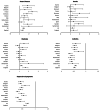Mortality and morbidity in ageing men: Biology, Lifestyle and Environment
- PMID: 35697963
- PMCID: PMC9748037
- DOI: 10.1007/s11154-022-09737-6
Mortality and morbidity in ageing men: Biology, Lifestyle and Environment
Abstract
Males live shorter lives than women in all countries. The universality of shorter male life expectancy is a 21st Century phenomena. It occurs with the decline in infectious diseases and the rise in cardiovascular diseases accounting for mortality. Male/female differences in morbidity are not as succinctly characterized. Men have a higher prevalence of lethal diseases, which is linked to their lower life expectancy. Women have more non-lethal conditions such as depression and arthritis; which may also be linked in part to longer survival. Men have better physical functioning and less disability which is partly explained by gender differences in diseases and also by their greater strength, size, and stamina. Gender differences in risk factors for disease have changed over time with the prevalence and treatment of risk as well as differential behavior by gender. Examination of what are seen as basic molecular and cellular measures related to aging indicates men age faster than women; however, even these basic biological measures result from a combination of biology, behavior, and social factors.
Keywords: Cholesterol; Diabetes; Epigenetic aging; Gender; Heart Disease; Hypertension; Life Expectancy; Sex; Stroke.
© 2022. The Author(s).
Conflict of interest statement
No conflict of interest.
Figures










Similar articles
-
The sex differential in morbidity, mortality, and lifestyle.Annu Rev Public Health. 1984;5:433-58. doi: 10.1146/annurev.pu.05.050184.002245. Annu Rev Public Health. 1984. PMID: 6372818 Review.
-
Sex differentials in health and mortality.Women Health. 1987;12(2):103-45. doi: 10.1300/J013v12n02_07. Women Health. 1987. PMID: 3424846
-
Gender differences in life expectancy with and without disability among older adults in Ecuador.Arch Gerontol Geriatr. 2015 Nov-Dec;61(3):472-9. doi: 10.1016/j.archger.2015.08.012. Epub 2015 Aug 10. Arch Gerontol Geriatr. 2015. PMID: 26316253
-
The global impact of noncommunicable diseases: estimates and projections.World Health Stat Q. 1988;41(3-4):255-66. World Health Stat Q. 1988. PMID: 3232413
-
Differences between Men and Women in Mortality and the Health Dimensions of the Morbidity Process.Clin Chem. 2019 Jan;65(1):135-145. doi: 10.1373/clinchem.2018.288332. Epub 2018 Nov 26. Clin Chem. 2019. PMID: 30478135 Free PMC article. Review.
Cited by
-
Chronic morbidity levels and associated factors among older adults in western Nepal: A cross-sectional study.J Multimorb Comorb. 2025 Mar 21;15:26335565251325920. doi: 10.1177/26335565251325920. eCollection 2025 Jan-Dec. J Multimorb Comorb. 2025. PMID: 40124196 Free PMC article.
-
Understanding the demographic and socioeconomic determinants of morbidity in Eastern Uganda: a retrospective analysis of the Iganga-Mayuge health and demographic surveillance data.BMJ Public Health. 2024 Nov 28;2(2):e000898. doi: 10.1136/bmjph-2024-000898. eCollection 2024 Dec. BMJ Public Health. 2024. PMID: 40018598 Free PMC article.
-
The Association Between Cardiometabolic Risk and Cognitive Function Among Older Americans and Chinese.J Gerontol A Biol Sci Med Sci. 2024 Jul 1;79(7):glae116. doi: 10.1093/gerona/glae116. J Gerontol A Biol Sci Med Sci. 2024. PMID: 38699992 Free PMC article.
-
Gender differences in the association between community care and quality of life among older adults in China.Sci Rep. 2025 Jul 9;15(1):24588. doi: 10.1038/s41598-025-06040-7. Sci Rep. 2025. PMID: 40628767 Free PMC article.
-
Sex differences in biological aging and the association with clinical measures in older adults.Geroscience. 2024 Apr;46(2):1775-1788. doi: 10.1007/s11357-023-00941-z. Epub 2023 Sep 25. Geroscience. 2024. PMID: 37747619 Free PMC article.
References
-
- United Nations, Department of Economic and Social Affairs, Population Division. World Population Prospects: The 2019 Revision, DVD Edition. Max Roser, Esteban Ortiz-Ospina and Hannah Ritchie - “Life Expectancy”. 2013. https://ourworldindata.org/life-expectancy. Accessed 19 Jan 2022.
Publication types
MeSH terms
Grants and funding
LinkOut - more resources
Full Text Sources
Medical

